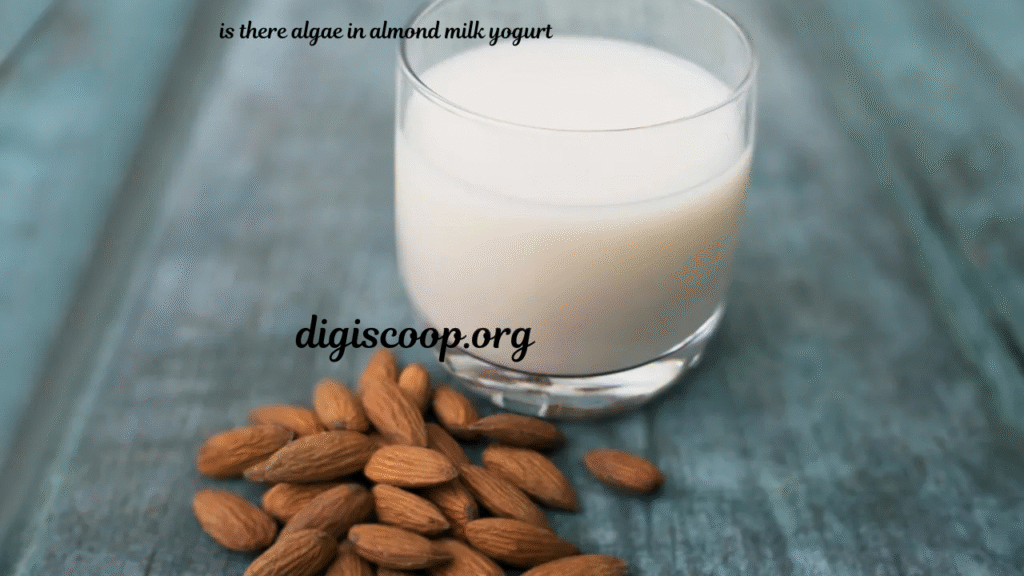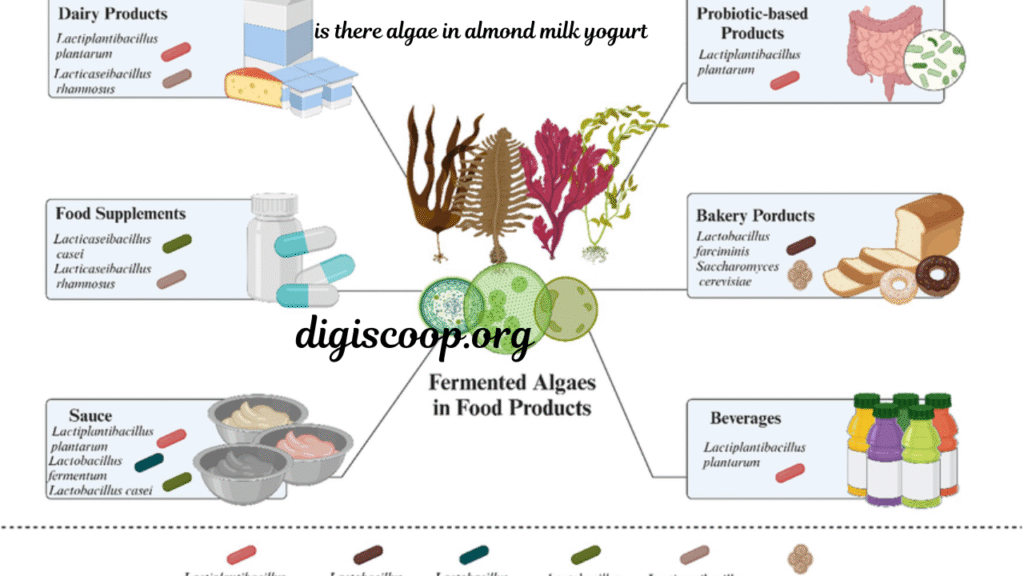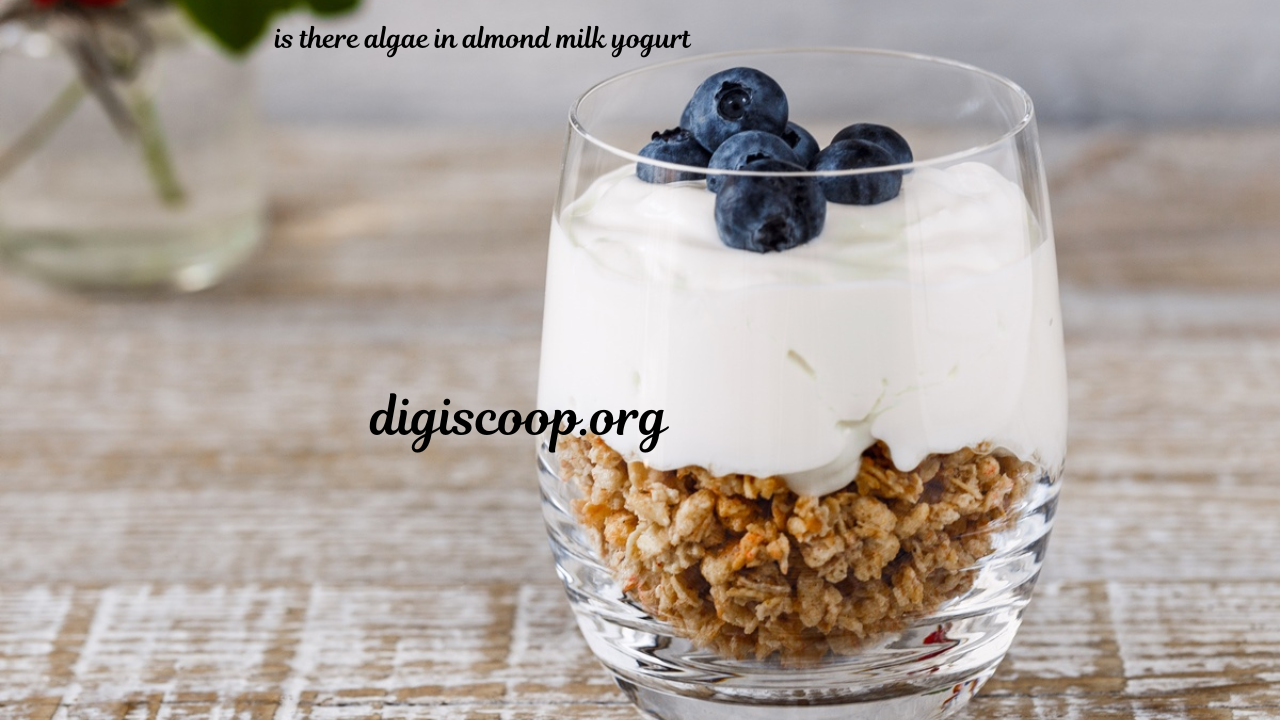Introduction to “Is There Algae in Almond Milk Yogurt, ??”
In recent years, plant-based foods have risen in popularity, with almond milk yogurt becoming a favorite for those seeking dairy-free, vegan-friendly alternatives. However, a curious question has emerged among health-conscious consumers: is there algae in almond milk yogurt, ?? This question combines both curiosity and concern, prompting people to look closer at labels, ingredients, and the role of algae-derived substances in food production.
The phrase may sound unusual, but it reflects a real topic in the world of plant-based nutrition. While almonds and yogurt cultures are the main focus, certain additives and stabilizers in dairy-free products can be derived from algae or seaweed. This leads to the need for a deeper investigation into whether almond milk yogurt contains algae and what role it might play.
Why People Are Asking: Is There Algae in Almond Milk Yogurt, ??

The question is there algae in almond milk yogurt, ?? has grown in online discussions due to several factors:
- Ingredient Curiosity – Consumers are paying more attention to what goes into their food.
- Vegan and Plant-Based Lifestyle Trends – People want to know if certain plant-based additives align with their dietary choices.
- Nutritional Concerns – Some worry about how algae-based ingredients affect texture, taste, or digestion.
- Natural vs. Processed Debate – Shoppers are trying to differentiate between naturally occurring food components and processed additives.
Many have noticed unusual ingredient names on almond milk yogurt labels—like carrageenan or agar—without realizing these may originate from seaweed or algae. This fuels the ongoing curiosity.
Understanding Algae-Derived Ingredients in Plant-Based Foods

To answer the question is there algae in almond milk yogurt, ??, it’s important to understand what “algae in food” actually means. Algae in this context rarely refers to the green, slimy substance you might imagine from a pond. Instead, it usually means processed extracts from seaweed or microalgae that serve functional purposes in food manufacturing.
Common Algae-Derived Additives
- Carrageenan – Extracted from red seaweed, used as a thickener and stabilizer.
- Agar-Agar – Another red algae derivative, often used as a gelling agent.
- Alginate – From brown algae, used for thickening and texture.
- Spirulina – A blue-green algae used for color and nutrition.
- DHA from Algal Oil – Extracted from microalgae, used for Omega-3 enrichment.
These ingredients help almond milk yogurt maintain creaminess, thickness, and stability—qualities normally achieved through dairy fats and proteins in traditional yogurt.
Almond Milk Yogurt and the Use of Algae-Derived Ingredients

When asking is there algae in almond milk yogurt, ??, the answer varies depending on the brand and product formulation. Many almond milk yogurt brands aim for a smooth, thick consistency similar to dairy yogurt. Since almond milk alone is thin and low in protein, companies often add natural stabilizers—some of which come from algae.
Why Use Algae-Derived Ingredients in Almond Milk Yogurt?
- Texture Enhancement – Without dairy, almond milk yogurt needs extra help to achieve creaminess.
- Shelf Stability – Algae-based thickeners keep the yogurt from separating.
- Nutrient Fortification – Microalgae can provide plant-based Omega-3 fatty acids.
- Vegan Compliance – Algae-based additives replace gelatin, which is animal-derived.
Health and Safety Aspects of Algae in Almond Milk Yogurt
If we explore is there algae in almond milk yogurt, ?? from a health perspective, algae-based ingredients are generally considered safe for most consumers. They have been used for centuries in various cultures, especially in Asian cuisine.
Possible Health Benefits
- Rich in Minerals – Seaweed and algae extracts can contain iodine, calcium, and magnesium.
- Digestive Aid – Certain algae-based fibers may promote gut health.
- Vegan Omega-3 Source – Microalgae provide DHA and EPA without relying on fish oil.
Considerations and Concerns
- Digestive Sensitivity – Some people report bloating or digestive discomfort from carrageenan.
- Allergies – While rare, some individuals may react to specific algae-derived ingredients.
- Overconsumption – Excessive iodine intake from algae sources may affect thyroid function.
Identifying Algae in Almond Milk Yogurt Labels
For those wondering is there algae in almond milk yogurt, ??, the best way to know is by reading the ingredient list carefully. Instead of seeing the word “algae” directly, you might find technical ingredient names. Here are some to look for:
- Carrageenan
- Agar or Agar-Agar
- Sodium Alginate
- Spirulina Extract
- Algal Oil or DHA from Algal Source
Brands vary—some avoid these additives entirely for “clean label” marketing, while others embrace them for improved texture and nutritional value.
Consumer Trends and the Future of Algae in Almond Milk Yogurt
As plant-based foods evolve, the discussion around is there algae in almond milk yogurt, ?? will likely continue. Future trends may include:
- Cleaner Labels – Some brands may reduce or replace algae-derived additives with other plant-based options like tapioca starch or oat fiber.
- Functional Nutrition – More almond milk yogurts may intentionally add microalgae for Omega-3 benefits.
- Transparency in Marketing – Companies may openly state their use of algae-derived ingredients to build trust.
- Customized Formulas – As demand grows, consumers might choose between algae-free and algae-enhanced versions.
Final Thoughts on “Is There Algae in Almond Milk Yogurt, ??”
So, is there algae in almond milk yogurt, ?? The answer is: it depends on the brand and product. While most almond milk yogurts don’t contain whole algae, many do include algae-derived stabilizers, thickeners, or nutrients. These ingredients serve functional purposes and are generally recognized as safe, but personal preferences and dietary needs vary.
For those avoiding algae, label reading is key. For others seeking plant-based nutritional boosts, algae-derived ingredients can be a beneficial addition to almond milk yogurt. Ultimately, understanding what goes into your food empowers you to make choices aligned with your taste, health goals, and values.
Also Read : Debra Tendrich, Champion of Health and Empowerment: A Life Dedicated to Community Well-Being







